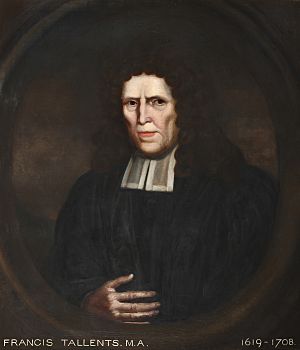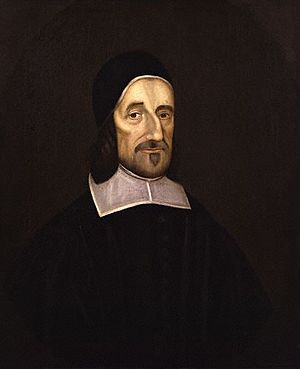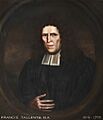Francis Tallents facts for kids
Francis Tallents (1619–1708) was an English Presbyterian clergyman who didn't follow the rules of the main Church of England. He was known for his strong beliefs and for teaching many students.
Contents
Early Life and Education
Francis Tallents was born in November 1619 in Pilsley, Derbyshire. His family had some Huguenot (French Protestant) roots. When he was 14, his father passed away. An uncle helped him go to free schools in Mansfield and Newark.
College Life and Becoming a Minister
In 1635, Francis Tallents started studying at Peterhouse, Cambridge. Later, he moved to Magdalene College, Cambridge to help teach the sons of a nobleman, the Earl of Suffolk. He earned his first degree in 1641.
In 1642, he traveled to France with his students. He spent time in Saumur, a town important for Huguenot teachings. This experience, seeing Roman Catholicism up close, made his Protestant beliefs even stronger. This was during the English Civil War, a time when your religious beliefs could decide which side you supported.
He returned to Cambridge, which was a stronghold for the Roundhead (Parliamentary) side in the war. He earned his master's degree in 1645. After this, he became a Fellow (a senior member) and a tutor at Magdalene College.
For several years, Tallents stayed in academic life. He was very interested in science, history, and Theology (the study of religion). He knew about the ideas of important thinkers like Jonas Moore and Johannes Kepler. He also learned about the "Invisible College" through Robert Boyle. This was a group of scientists and thinkers who believed in universal ideas and a better future. Tallents was a talented teacher, and one of his students, Robert Sawyer, later became a top lawyer for England.
In 1648, Tallents officially became a minister in London. In 1649, he was chosen as one of twelve university graduates allowed to preach without needing permission from a bishop.
Minister in Shrewsbury
In 1652, the leaders of Shrewsbury invited Tallents to become a lecturer and curate at St Mary's Church, Shrewsbury. This church was very old and had a special status, but the town council was in charge of it. Richard Baxter, a well-known Puritan preacher, strongly encouraged Tallents to take the job.
The previous minister had left because of political changes. The Rump Parliament had asked people to take an "Oath of Engagement," which many Presbyterians didn't like. So, the town needed a new minister.
Richard Baxter highly recommended Tallents, calling him "a good Schollar, a godly, blameless Divine, most eminent for extraordinary Prudence, and moderation." Baxter told Tallents that the people of Shrewsbury were "very serious, sober Christians" and that the church was a good place to preach.
Tallents was a bit worried because the previous minister was still around. But the former minister, Samuel Fisher, wrote to the parish saying he "earnestly desired" Tallents to take the position. This helped Tallents decide, and he accepted the job in January 1653.
Even as a minister, Tallents sometimes didn't follow all the new rules. For example, in 1653, a new law said that all marriages had to be performed by a Justice of the Peace (a local official). Tallents disagreed. He continued to lead the marriage ceremony himself, only letting the Justice of the Peace speak at the very end to make it official. That same year, he married Anne Lomax.
Tallents also helped on a larger scale. In 1654, he was part of a group that decided if ministers and schoolteachers in Shropshire were doing a good job. They removed some who were not popular or were seen as unfit.
He was also involved in religious debates. In 1656, he led a discussion in Ellesmere about infant baptism, where a Baptist minister argued against it.
Being Removed from His Post
After the king returned to power in 1660 (the Stuart Restoration), there was a push to bring back ministers who had been removed during the Civil War. Many people wanted Tallents to stay in Shrewsbury, even the minister who had been there before him.
However, there was a big political struggle in Shrewsbury. The Lord Lieutenant of Shropshire, Francis Lord Newport, and his deputy, Richard Ottley, wanted to remove Presbyterians from power. In December 1661, the Corporation Act 1661 was passed. This law required officials to reject the "Solemn League and Covenant," a promise many Presbyterians had made. Newport and Ottley used this to remove Tallents's supporters from the town council.
In 1662, the Act of Uniformity 1662 was passed. This law made it clear that all ministers had to follow the rules of the Church of England. They had to use the Book of Common Prayer, agree to everything in it, reject the Solemn League and Covenant, and accept being ordained again by a bishop if they hadn't been.
Tallents refused to be ordained again by a bishop. Because of this, he was ejected (removed) from his position in September 1662. He was even imprisoned several times in Shrewsbury Castle for continuing to preach.
After Being Ejected
After 1662, Francis Tallents still went to St Mary's Church, but he only preached at different times. From 1671 to 1674, he lived near Paris, France, with one of his former students. When he returned, he joined another minister, John Bryan, in leading a Presbyterian church in Shrewsbury.
He was suspected of being involved in a rebellion in 1685 and was held in Chester Castle, but he was soon released. In 1687, when King James II visited Shrewsbury, Tallents was part of a group that gave the king a gift to show thanks for the Declaration of Indulgence, which gave more freedom to non-Anglican Protestants.
Shrewsbury Academy
Around 1697, Tallents started a school in Shrewsbury called Shrewsbury Academy. It was a "dissenting academy," meaning it was for students who didn't follow the Church of England. After 1699, the school was led by James Owen and later Samuel Benion. It continued until about 1708.
Death
Francis Tallents passed away in Shrewsbury on April 11, 1708, when he was almost 89 years old. He was buried in St Mary's Church. He even wrote his own epitaph (the words on his tombstone).
Writings
Francis Tallents wrote several books and papers. His 1705 book, A Short History of Schism, caused a debate with another clergyman, Samuel Grascome.
Besides a sermon he preached at the funeral of Philip Henry, Tallents published:
- A View of Universal History (1685): This was a series of timeline charts that he engraved himself.
- A Sure and Large Foundation (1689?): Not much is known about this work today.
- A Short History of Schism (1705): This book led to a public argument with Samuel Grascome, who wrote replies to Tallents's work.
Tallents also kept a journal of his travels, which was later used by historians to write about Shrewsbury.
Family Life
Francis Tallents was married four times:
- In 1654, to Anne Lomax. They had two sons, but only one, Francis, lived past infancy. This son also went to Magdalene College, Cambridge, and became a chaplain before he died young.
- In 1661, to Martha Clive.
- In 1673, to Mrs. Mary Greenhill.
- In 1688, to Elizabeth.
His nephew, Francis Hutchinson, was also a historian. Tallents helped him with his studies and asked him to take his View of Universal History manuscript to other scholars for their corrections before it was printed.
Images for kids





